Birds & Nature: Northern Hardwood Forest
When we understand place, we become better birders and better stewards
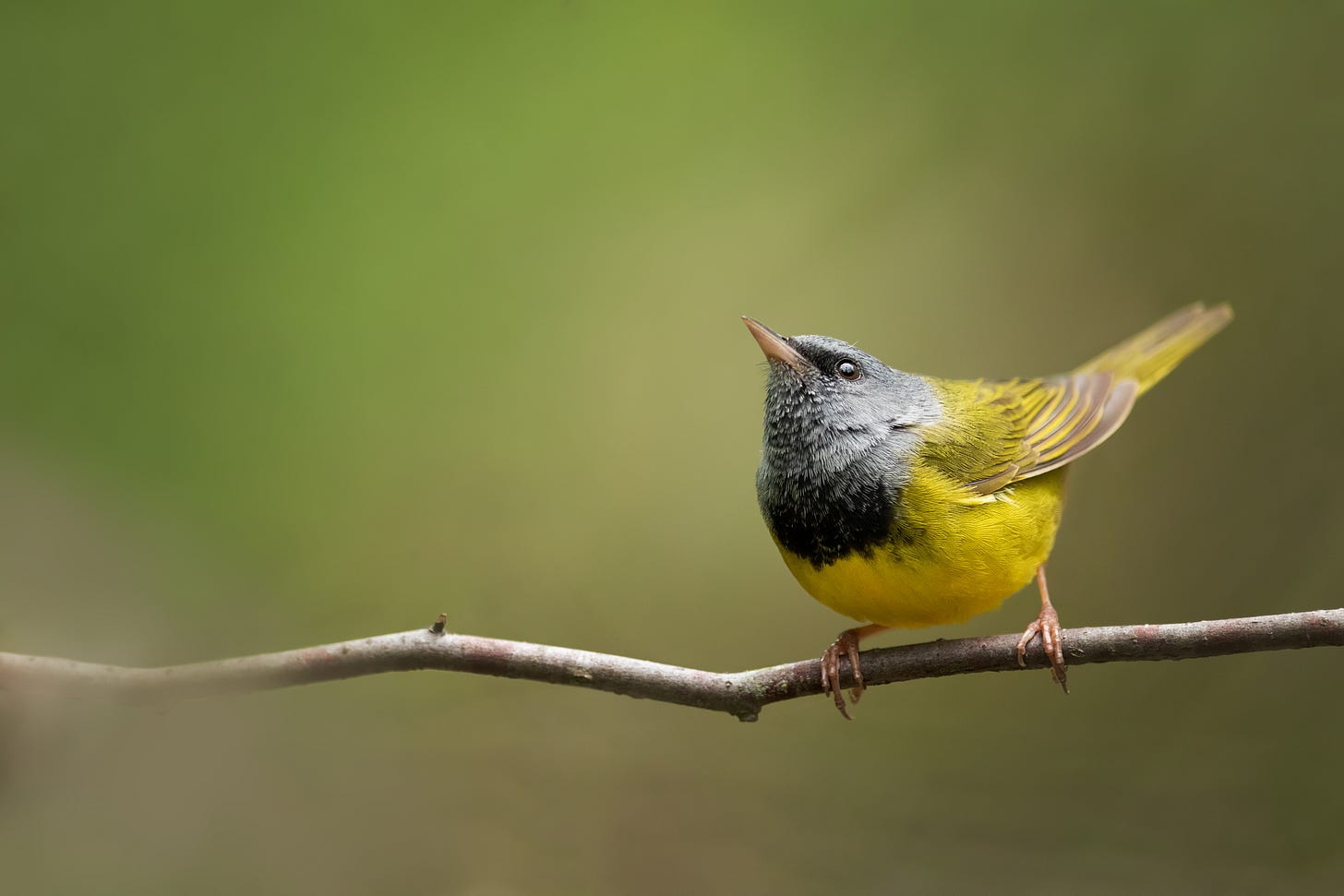
Welcome to the birdy side of the internet! As part of our monthly Birds & Nature edition—published during the fourth week of each month—we’re zooming in on the rich relationship between birds and the broader ecosystems they inhabit. Understanding this connection not only deepens our appreciation for the natural world but also sharpens our birding skills and strengthens our roles as thoughtful stewards.
From the dazzling diversity of hummingbirds in Arizona’s sky islands to the urgent need to protect coastal habitats, this issue highlights a range of landscapes and the birds that depend on them. Since birding is rooted in place, we want to hear from you: what’s your favorite habitat to explore? Cast your vote in the weekly poll and share your go-to spots in the comments!
We’re also thrilled to welcome our first guest contributor, Hayley Kolding, birder and botanist, who brings her deep ecological knowledge and passion for place to this month’s Plant Community Spotlight. We’re excited to share her perspective and look forward to featuring more of her work in upcoming issues.
This Week in Birding History: Hummingbird Haven
June 30, 2002 — Twenty-three years ago this week, dedicated eBirders Mark Stevenson, Shawneen Finnegan, and a few others managed a rare feat in southeast Arizona - documenting 13 hummingbird species in a single outing! Thanks to the hummingbird magic that happens in Southeast Arizona’s “sky islands,” it only took the group three hours of effort across five acres to rack up a baker’s dozen of hummingbirds. The list included a mixture of common western species (Anna’s, Rufous, Black-chinned), local specialties (Rivoli’s, Lucifer, White-eared), and a rare Plain-capped Starthroat.
This memorable afternoon played out at Beatty’s Guest Ranch, a small-scale farm and lodging site that caters to hummingbird enthusiasts with countless hummingbird feeders throughout the grounds and bleacher seating. Nestled in the center of the Huachuca Mountains’ Miller Canyon, the ranch’s all-time hummingbird list stands at 15 species, plus the hybrid Rivoli’s x Berylline Hummingbird. According to their website, 14 species were observed on a single day in both 2002 and 2006—a supposed record for the United States. Such hummingbird diversity stems from the site’s geography, where isolated mountains rise thousands of feet above low-elevation deserts and grasslands. Habitats on the mountain slopes change proportionately with elevation, with some of the mountain peaks supporting spruce-fir forests typical of much more northern regions of the Rocky Mountains. The sky islands’ remarkably broad spectrum of habitats in close proximity is what drives the hummingbird magic of southeastern Arizona.
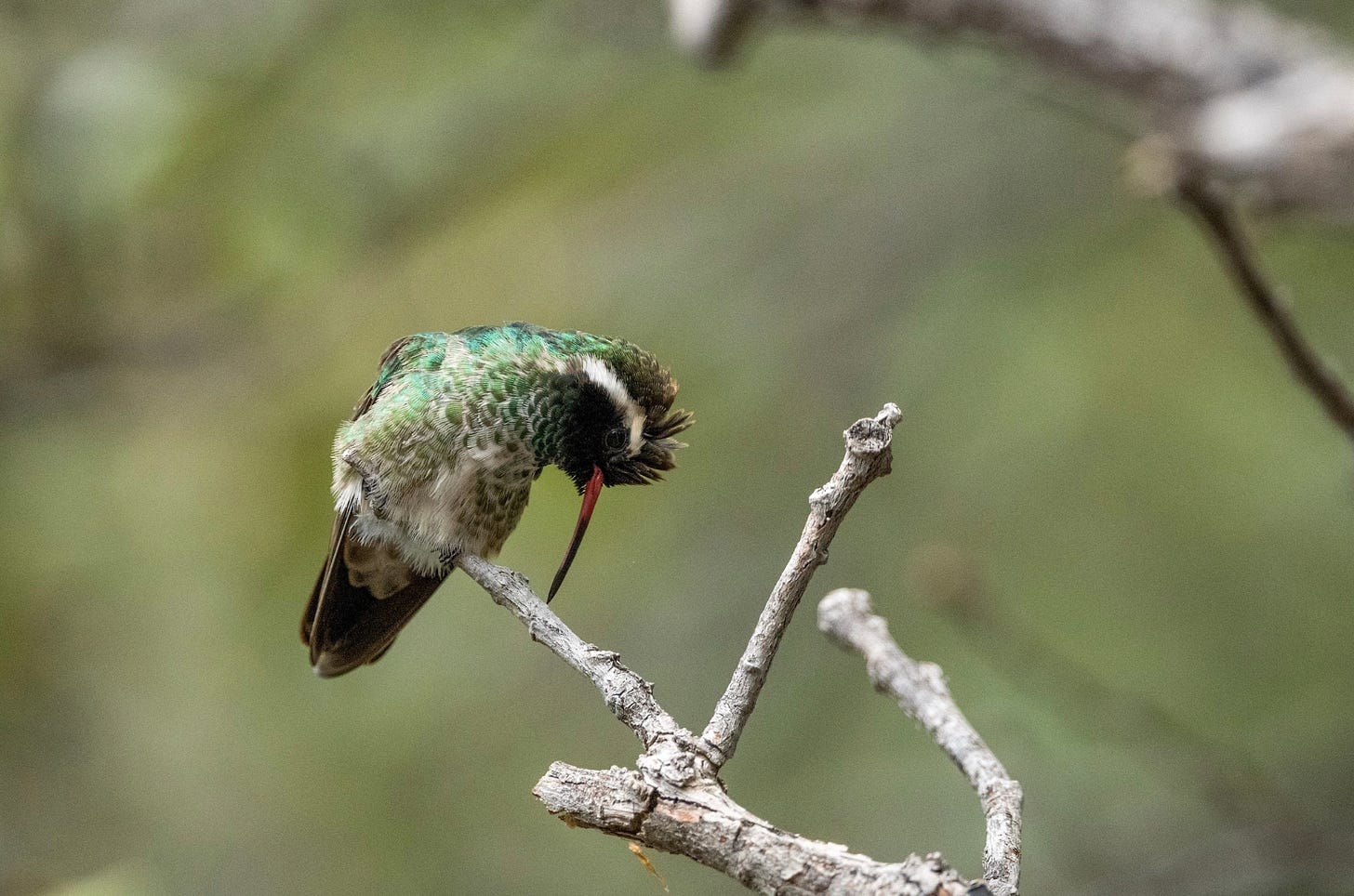
Birding Tip: Using Nature as Your Guide
A couple of weeks ago, we discussed how natural history can aid in identifying bird species (for more info, check out this post). The big takeaway is that underlying patterns drive much of nature. Evolution is shaped by selective pressures, just as bird behavior is influenced by its habitat and the availability of resources. Keeping this in mind while birding can enrich your experience in meaningful ways.
Finding Target Species
Attuning yourself to nature’s clues will improve your ability to find target species. For example, in the boreal forests of North America, spruce budworm outbreaks can greatly influence the breeding success of certain warbler species. Knowing that Tennessee, Cape May, and Bay-breasted Warblers depend heavily on these outbreaks provides valuable insight into where to find them. It also explains why a high number of these warblers during fall migration often signals a strong budworm outbreak that supported a successful breeding season.
Understanding the preferred food sources for specific species might seem like a general observation, but it’s far more potent than it appears.
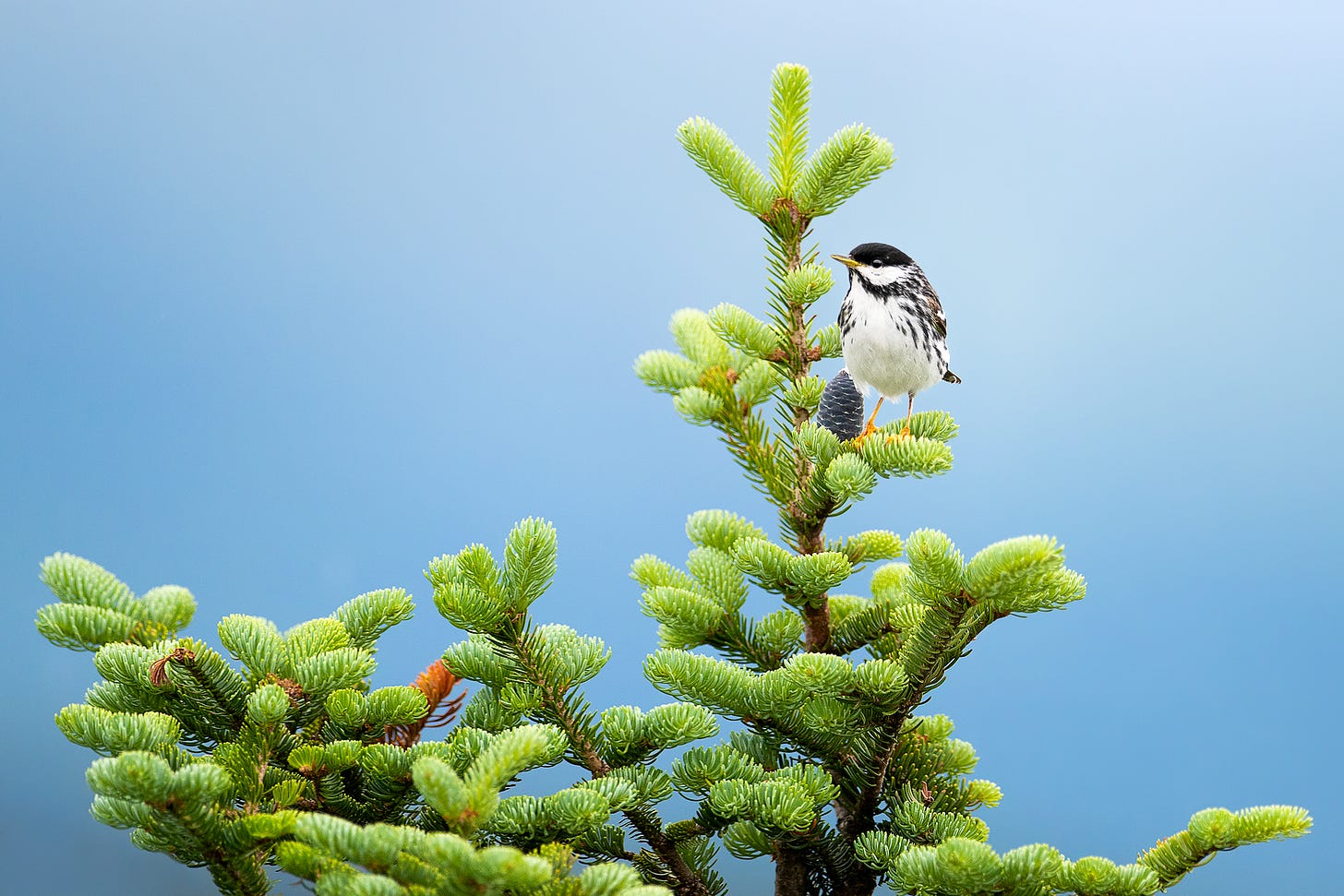
Research on Red Crossbills shows that their reliance on different cone types is driving physiological changes, laying the groundwork for speciation. This is evident in the Cassia Crossbill, which evolved from the Red Crossbill and was once called the South Hills Crossbill or Type 9 Red Crossbill due to its unique dependence on lodgepole pine forests in southern Idaho. There, the absence of red squirrels means Cassia Crossbills don’t need to travel far for food, leading them to become sedentary, a key reason they have evolved into a distinct species. However, without squirrels to open the cones, the local pinecones developed thicker scales for protection from the crossbills, which in turn drove the crossbills to evolve into larger birds with shorter, deeper, and more downcurved bills. This distinct species was officially recognized in 2017.
Editor’s note: Birding University acknowledges the ongoing debate surrounding whether the Cassia Crossbill's split from the Red Crossbill was premature, given that these birds are not found exclusively in Idaho, as previously believed—confirmed audio detections have been recorded in Colorado, Wyoming, and even California.
Sharing Your Experience
A considerable part of birding is sharing your discoveries with others. But anyone who’s birded in groups knows that’s often easier said than done. Trying to point out a brilliantly red Scarlet Tanager high in the canopy can be more complicated than finding it in the first place. A helpful trick is to use the plants birds associate with to direct attention. Instead of saying, “It’s up there,” you can say, “Look at the canopy of that Shagbark Hickory with the peeling bark.”
This habit sharpens your observational skills. You’ll begin to notice details like wilted milkweed signaling late-season monarch activity or fresh catkin blooms indicating the arrival of Pine Siskins. These cues expand your focus beyond the bird, making every walk a more profound lesson in the ecosystem around you. Over time, your mental map of habitats and species will grow, and you’ll instinctively know where to look for a Marsh Wren or a Rose-breasted Grosbeak just by reading the landscape.
Non-Plant Related Nature Tips
Patterns in nature aren’t limited to plants. Weather can influence bird behavior just as much as habitat does. On cool mornings, birds often follow the sun. Picture a crisp fall day searching for migrants—you’ll usually find them on the sunny side of a shrub line where insects are more active.
Larger weather patterns also play a significant role. Wind impacts raptor migration and can push vagrants into unusual places. Monitoring strong winds or tracking pressure patterns, such as the North Atlantic Oscillation (NAO) or Pacific Decadal Oscillation (PDO), can help guide you toward the right places and species. Rainstorms often ground migrating birds, so a wet morning could be perfect for scanning a local lake for waterbirds and waterfowl. Frequently, this is the most effective technique for finding species in your local patch that are otherwise rare.
Let Nature Be Your Guide
Using nature as your guide leads to a more holistic understanding of the world around you. Nature becomes both your field guide and your teacher, revealing where to look and what to look for. The more you tune into these patterns, the more skilled—and fulfilled—you’ll become as a birder.
Bird’s Eye View: Coastal Birds, Habitat Restoration, and Stewardship
New research from the National Audubon Society highlights that coastal birds depend on a combination of strategies to survive and thrive. Focused on the Gulf Coast but applicable everywhere, the study shows that the most effective conservation efforts pair habitat management with on-the-ground stewardship. Protecting birds from human disturbance by roping off nesting areas or posting signs is essential. Still, it’s even more effective when paired with habitat improvements, such as beach nourishment, vegetation management, and reducing harmful practices like beach raking.
For beach-nesting birds like Least Terns, Snowy Plovers, and American Oystercatchers, the threats are constant and growing. Rising seas, stronger storms, and disappearing habitats intersect with everyday pressures from beachgoers, dogs, and vehicles. These challenges aren’t limited to the Gulf—they’re happening on shorelines across the country and around the world. The research is clear: when communities invest in long-term, adaptive approaches that address both disturbance and habitat loss together, coastal bird populations can rebound.
As summer brings more people to the beach, it also marks the peak of nesting season for many birds. You can help by respecting roped-off areas, keeping dogs leashed on bird-friendly beaches (or keep them home altogether), and packing out trash that might attract predators. Small actions, such as providing nesting birds with ample space or gently reminding others to share the shore, can make a significant difference.
If you want to do even more, consider joining a local stewardship program or starting one in your community, using resources such as Audubon’s Social Media Toolkit from their Coastal Bird Stewardship Campaign.
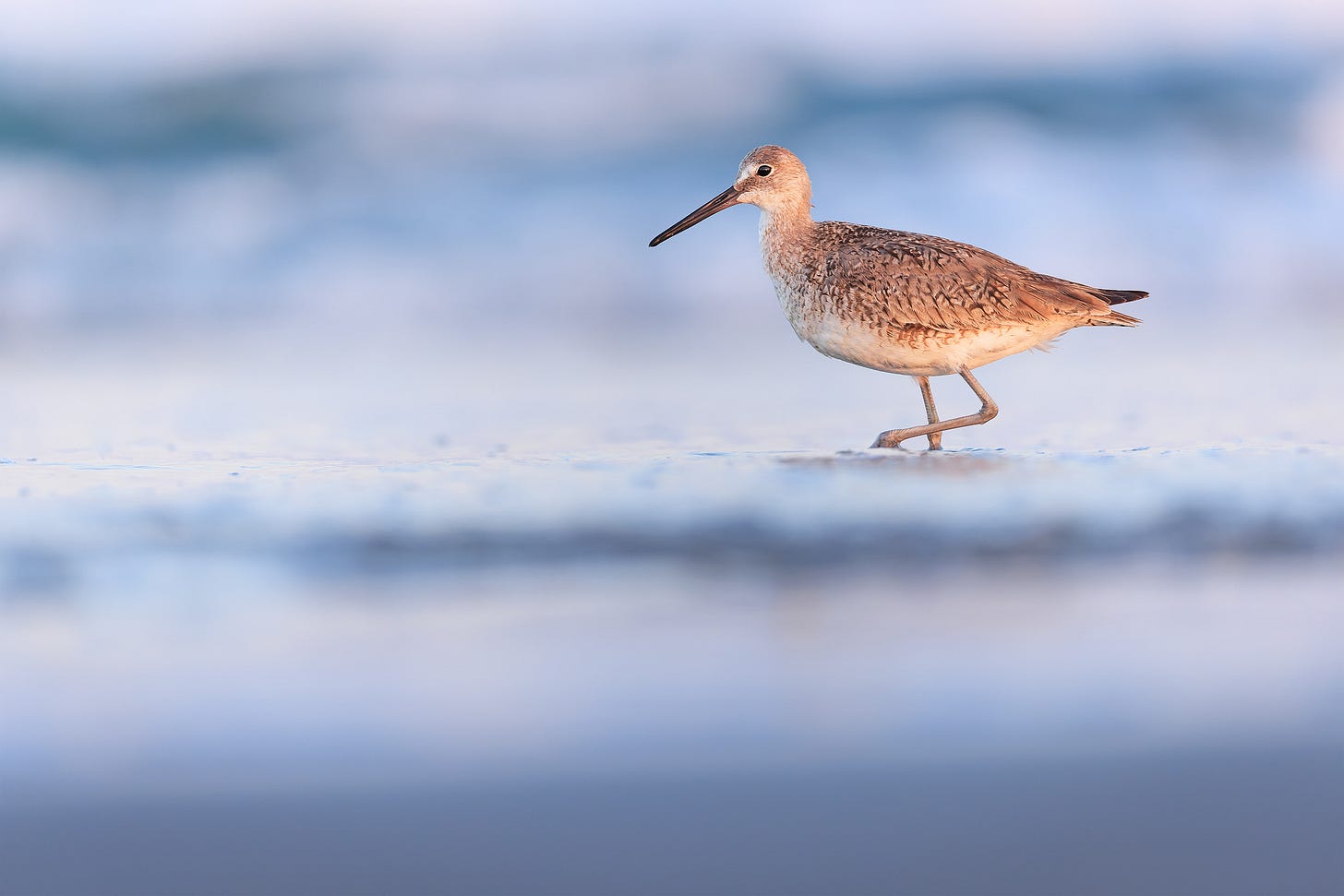
Plant Community Spotlight: Northern Hardwood Forest
On a humid June morning in New England, the dawn chorus rises from the ground up: an Ovenbird chants “teacher-teacher-teacher” from the forest floor; a Hermit Thrush’s flute-like notes echo from the understory; Chestnut-sided and Black-throated Blue Warblers trade bright, quick phrases from dense thickets near canopy gaps. A Veery’s song spirals through the midstory. Above, a pair of Golden-crowned Kinglets whistle from the highest branches while a Yellow-bellied Sapsucker adds a staccato rhythm on a dead snag.
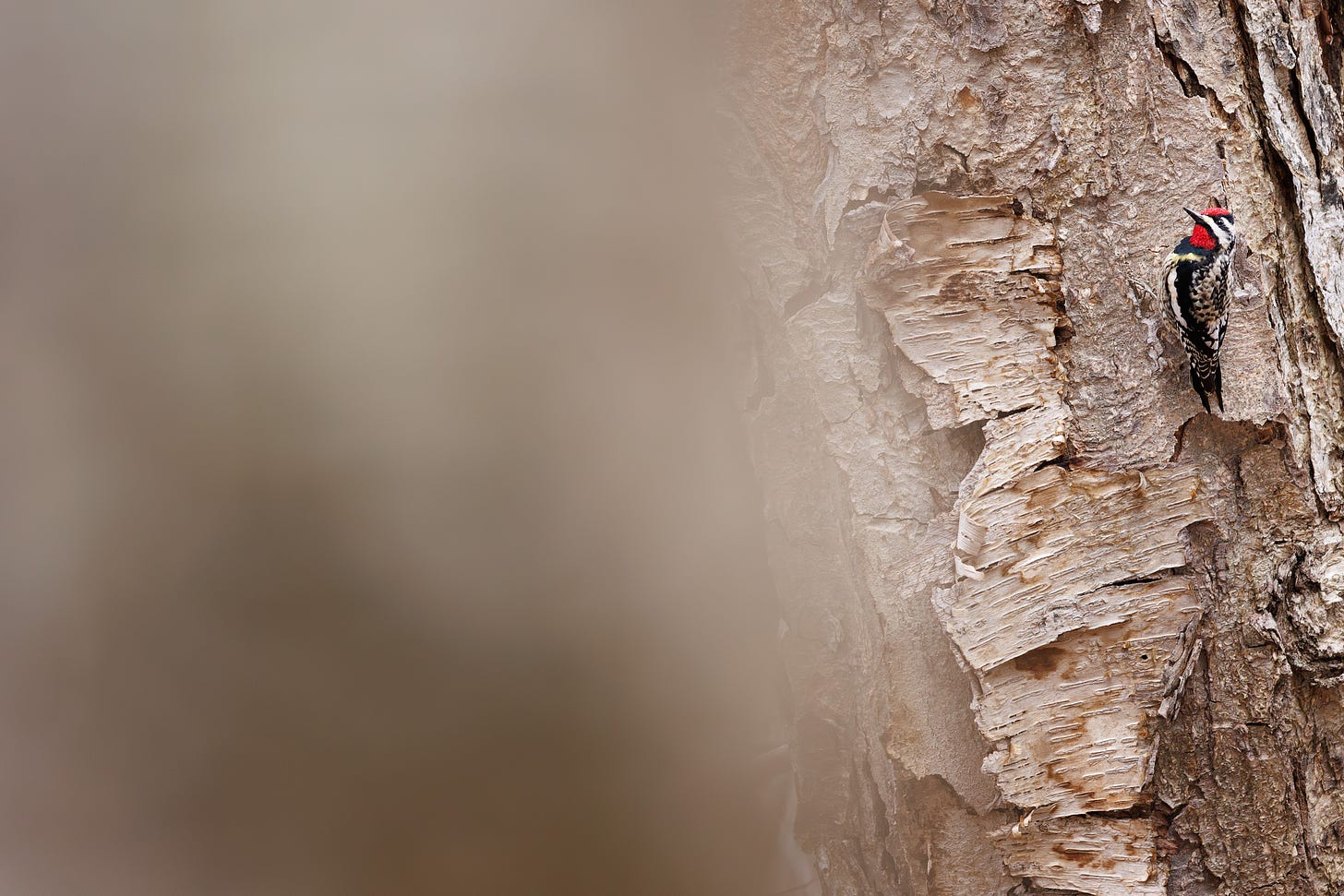
Together, these birds fill out the soundscape of the Northern Hardwood Forest—a subset of the Nearctic Temperate Deciduous Forest—where sugar maple, American beech, and yellow birch grow in cool, loamy soils. These forests are dynamic, shaped by time, disturbance, and renewal. Windstorms, ice storms, and native insect outbreaks, as well as the deaths of individual old trees, open light-filled gaps, setting in motion a successional cycle—from sun-soaked clearings to thickets of raspberry, blackberry, and saplings to multi-layered, mature stands. As a patch’s species composition and structure shift, so does its bird community.
Mourning Warblers take advantage of early growth, appearing soon after disturbance when dense shrubs emerge. Red-eyed Vireos, Wood Thrushes, and Rose-breasted Grosbeaks thrive in the leafy midstory, where insects abound. Scarlet Tanagers sing boldly from the canopy while American Goshawks slip silently between trunks. Pileated Woodpeckers excavate cavities in the towering snags found in mature forests, while Yellow-bellied Sapsuckers and Hairy Woodpeckers tap and forage along decaying wood.
Every sound and movement reveals an intimacy with the shifting forest. The rustle of leaf litter might be an Ovenbird foraging or clearing a spot for her shaded nest. Overhead, the soft patter of frass—caterpillar droppings—tells of unseen abundance feeding warblers and vireos. A Brown Creeper hops up a trunk while a Red-breasted Nuthatch probes under bark, drawn to the invertebrates nestled in moss and furrowed bark.
Then, a crash—a branch splinters, a trunk gives way, and sunlight floods the forest floor. It’s the start of renewal. Light-loving plants take hold. Barred Owls and Black-Capped Chickadees claim new cavities. Beetles and fungi break down the fallen wood, enriching the soil for the next generation of trees and birds.
These rhythms echo across broadleaf forests throughout North America. Though the tree species may change, the dance of disturbance and regeneration is familiar. For birders and forest stewards alike, understanding these cycles and how birds respond to them adds richness to every song heard at dawn and meaning to every step beneath the trees.
Weekly Poll
Don’t see your favorite? Maybe you’re a shrubland fan, a lover of mountains, an open-ocean birder, or something else entirely—let us know in the comments!
Thanks for Reading
We hope this week’s issue has inspired you to look a little closer and think a little deeper about the places we bird. We’re grateful to have you with us on this journey, whether you’re a seasoned birder or just beginning to discover the joys of the natural world. Your curiosity and care make a real difference for birds and their habitats. If you enjoyed this issue, please share it with friends, join the conversation in the comments, and don’t forget to cast your vote in our weekly poll. Together, we’re building a community of birders who watch, learn, and protect—one habitat at a time.
* Please visit Phil Stollsteimer Photography for more amazing bird photography.








Fantastic imagery of the Northern Hardwood forest! I felt as though I was there :)
Check out my recent piece on bird interactions in cities.